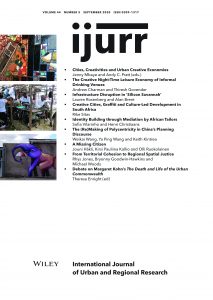Debates around urbanization, infrastructure disruption and the creative class rarely appear alongside each other in research on African cities. This article connects these different narratives, which are currently exerting their influence on the future direction of these cities. The economic value of the creative class is that their work centres on innovation—a quality seen as essential to ‘new‐economy’ urban growth. Quality of place (that which makes ‘New York New York’) is said to attract the creative class to certain cities, as lifestyle amenities are valued as much as employment opportunities. Nairobi is an example of an African city currently attracting both Kenyan and expatriate creative class workers, particularly in the information and communication technology (ICT) sector. In this article we take Richard Florida’s creative class theory as a departure point to offer insights into why this group chooses to live in Nairobi and to describe Nairobi’s quality of place, with a particular focus on infrastructure disruption. The case study reveals that Nairobi’s quality of place differs fundamentally from the normative attributes prescribed by creative class theory and, in some instances, it is considered to be highly frustrating and unattractive.
Details
Written by:
Lauren Rosenberg & Alan Brent
Digital Object Identifier (DOI)
10.1111/1468-2427.12895
About DOI

